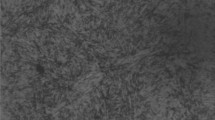Abstract
An investigation of the surface chemistry and morphology of the wear surfaces of ceramic material surfaces modified by ion beam mixing has been conducted using Auger electron spectroscopy and secondary electron microscopy. Studies have been conducted on ceramic/ceramic friction and wear couples made up of TiC and NiMo-bonded TiC cermet pins run against Si3N4 and partially stabilized zirconia disc surfaces modified by the ion beam mixing of titanium and nickel, as well as unmodified ceramic/ceramic couples in order to determine the types of surface changes leading to the improved friction and wear behaviour of the surface modified ceramics in simulated diesel environments. The results of the surface analyses indicate that the formation of a lubricating oxide layer of titanium and nickel, is responsible for the improvement in ceramic friction and wear behaviour. The beneficial effect of this oxide layer depends on several factors, including the adherence of the surface modified layer or subsequently formed oxide layer to the disc substrate, the substrate materials, the conditions of ion beam mixing, and the environmental conditions.
Similar content being viewed by others
References
J. Lankford andW. Wei,J. Mater. Sci. 22 (1987) 000.
B. Carriere, J. P. Deville andS. Goldsztaub,Vacuum 22 (1972) 485.
B. Carriere andB. Lang,Surf. Sci. 64 (1977) 209.
F. Fransen et al.Surf. Interface Anal. 7 (1985) 79.
O. C. Wells et al. in “Scanning Elecron Microscopy” (McGraw-Hill, New York, 1974) p. 150.
H. L. Marcus, J. M. Harris andF. J. Szalkowski, in “Fracture Mechanics of Ceramics” Vol. 1: “Concepts, Flaws and Fractography”, edited by R. C. Bradt et al. (Plenum, New York, 1974) p. 387.
C. G. Pantano andT. E. Madey,Appl. Surf. Sci. 7 (1981) 115.
H. Viefhaus, private communication (1985).
S. Hofmann, in “Practical Surface Analysis by Auger and X-ray Photoelectron Spectroscopy”, edited by D. Briggs and M. P. Seah (John Wiley, Chichester, 1983) Ch. 4, p. 141.
P. H. Holloway andR. A. Outlaw, ibid.111 (1981) 300.
H. E. Bishop, J. C. Rivière andJ. P. Coad,Surf. Sci. 24 (1971) 1.
M. C. Burrell andN. R. Armstrong,J. Vac. Sci. Tech. A 1 (1983) 1831.
L. E. Davis, N. C. MacDonald, P. W. Palmberg, G. E. Riach andR. E. Weber, (eds) “Handbook of Auger Electron Spectroscopy” 2nd Edn. (Perkin-Elmer Corp., Eden Prairie, Minnesota 1978).
P. H. McBreen andM. Polak,Surf. Sci. 163 (1985) L666.
N. P. Suh,Wear 25 (1973) 111.
D. H. Buckley, “Surface Effects in Adhesion, Friction, Wear, and Lubrication”, Tribology Series No. 5 (Elsevier, Amsterdam, 1984).
I. L. Singer,Appl. Surf. Sci. 18 (1984) 28.
Author information
Authors and Affiliations
Rights and permissions
About this article
Cite this article
Wei, W., Lankford, J. Characterization of ion beam modified ceramic wear surfaces using Auger electron spectroscopy. J Mater Sci 22, 2387–2396 (1987). https://doi.org/10.1007/BF01082121
Received:
Accepted:
Issue Date:
DOI: https://doi.org/10.1007/BF01082121




